
Standard Telephones and Cables Ltd. (STC) was yet another great British electrical manufacturer with a long and distinguished history that could not make the transition to the world of modern electronics and vanished in the early 1990's. Although it was, to all intents and purposes, a British company, it was in fact founded as part of Western Electric, and owned by ITT for most of its life.
In the 1950's and 1960's STC played a major role in British semiconductor research and development, which was not far behind the Americans. As with Mullard, much more information can be found about STC's valves/tubes (usually branded 'BRIMAR' which I have read stands for BRItish Made American Range, although this brand was sold to Thorn-AEI in 1960) than about their semiconductors. Their research laboratory and manufacturing plant was based in Footscray, Kent. STC did have an operation in Australia, and I show some of their early semiconductors on my Australia page.
In the 1960s and 1970s STC became a leader in submarine cables and long-distance telephony equipment. It developed and manufactured specialised integrated circuits for this application. From 1979 to 1982 ITT sold the majority of its holding in STC and eventually in 1991 STC was bought by Canadian company Northern Telecom.
If you know anything about STC's early semiconductors, please
STC's main germanium semiconductor product lines were the TK, ACY and ASY series of germanium transistors. They made few power transistors. Their devices bear either the logo shown or the letters STC, plus the type number in capitals e.g. ACY34, and often a two-letter code which I do not know how to decode, or even whether it is a date code or something else. It looks like the CV series date code, but is not. If you can help, please
STC made many more modern types of devices than I show here. In particular they manufactured silicon transistors, hybrid integrated circuits, and even some ICs based on tunnel diodes. The situation is confused by the relationship with the parent ITT, so if you have information about any of their semiconductors, please share it with me.
I do not possess all the devices mentioned below, in fact I am seeking many of them. It is noted in the text where I am seeking examples of any particular type: if you have some for sale or exchange, please
Conversely, I am happy to help anyone looking for information on these devices. I have an extensive collection of original data sheets and books from the period 1958 to about 1966, and can provide characteristic data on almost all early STC types.
One of the sources of information about early STC semiconductors is the 'Brimar Radio Valve and Teletube Manual', a softcover book that was published over an extended period. Issues are numbered rather than dated, but dates can be found on the Web. Only a few are of interest in terms of semiconductors:
- 1953 No.5 - the first issue with semiconductors : GD3 and GD4 germanium diodes.
- 1955 No.6 - the first issue with transistors : GD3, GD4, GD5, TJ1, TJ2, TJ3, TP1, TP2.
- 1958 No.7 - GD3, GD4, GD5, TJ1, TJ2, TJ3, TS1, TS2, TS3, TP1, TP2.
- 1959 No.8 - GD3, GD4, GD5, GD6, GD8, GD9, GD10, GD11, GD12, TS1, TS2, TS3, TS4, TS7, TS8, TS9, TS13, TS14, TS17.
- 1961 No.9 - no semiconductor data - presumably now in separate publications.
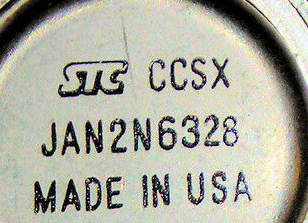
Before I go further I must raise a possible source of confusion: there is a US firm called Silicon Transistor Corporation which uses the abbreviation STC on its transistors, sometimes in hollow italics as shown here, and sometimes just in normal letters. This company has no connection with the English STC, and I have no data on Silicon Transistor Corporation devices.
The first transistors made by Standard Telephones and Cables are found in two apparently experimental series: the 3X/ series and the LS series. I am unsure why two series exist. There are also 2X/ series diodes, so I surmise that 3X/ means 'experimental triode'. The 3X/10n sub-series contains point-contact transistors, the 3X/30n sub-series contains junction transistors, and the LS series contains both. If anyone can elucidate this, please
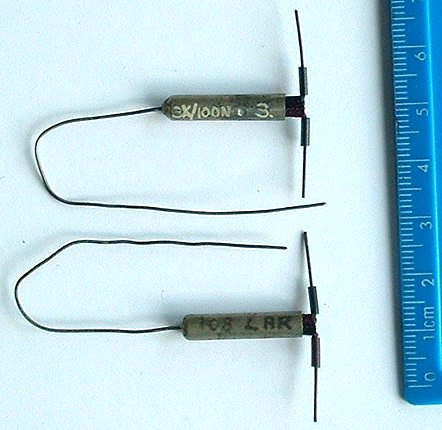
Certainly amongst the first STC types were the 3X/100N and 3X/101N point-contact switching prototypes, for which I have data sheets dated 1953. Coblenz and Owens book from 1955, one of the very first publications on transistors, shows an unidentified STC device that the authors state was made in 1949. These transistors are characteristic of early point-contact types in that the base lead emerges from the opposite end of the cylindrical can from the emitter and collector. This is because the base wire is attached to one side of the germanium die, and the collector and emitter point-contacts press upon the other. Both types use a long cylindrical steel can, with a serial number crudely etched into the metal. The 3X/100N has its part number hand-painted in white, the 3X101N has no other identification on the body, but the part number can be determined by the colour of the short sleeves on the emitter and collector leads: black+black for 3X/100N and black+brown for 3X/101N.
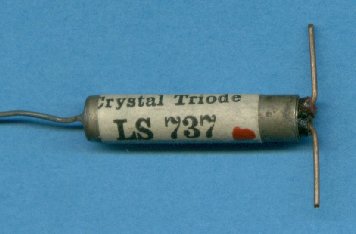
The LS series contained two point-contact transistors that I know of: LS736 and LS737. My image shows the latter bearing a paper label printed 'LS737 STC CRYSTAL TRIODE' plus a handwritten serial number. I have a number of these, as do other collectors I know, and the label may have the wording either along or around the body. This transistor appears to be the commonest STC point-contact type, but strangely, it is not mentioned in any contemporary publication that I know. I do have a very basic data sheet that I obtained from Harwell Laboratory, otherwise I would know nothing about it. I am seeking examples of LS736, and original data sheets for both LS736 and LS737. If you can help please
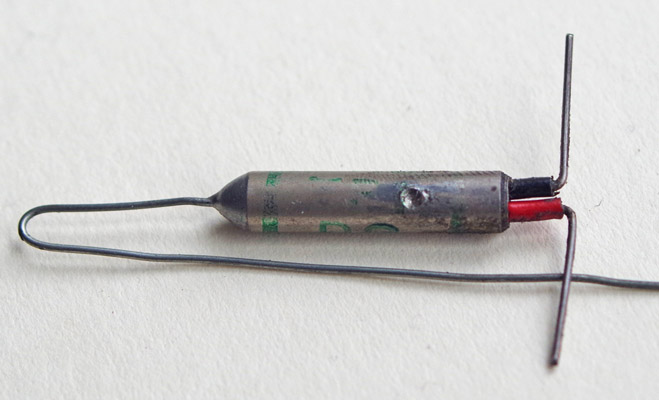
Two point-contact transistors were sold commercially by STC, the TP1 and TP2 listed in the Brimar Manual number 6 (for 1955). The upper image shows a TP1, apparently unused. It has the same body shape as the 3X/ types and the LS737.
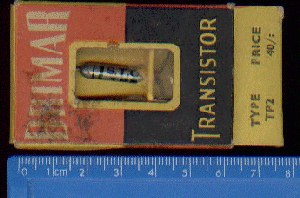
The lower image shows a TP2 in its original box, using STC's 'Brimar' branding. A small label on the box indicates that this device was sold at the famous Lasky's shop in Tottenham Court Road, London (visible in an image on this page). The price is marked as 40 shillings, which was two (pre-decimal) pounds Sterling. Using the Bank of England's inflation calculator, that is about £53.60 today.
It is possible that the TP1 and TP2 were commercial versions of the 3X/100N and 3X/101N, but I have no proof of this. I am seeking examples of both TP1 and TP2. I also wish to buy original data sheets for both of these devices. If you can help, or just provide information on them, please
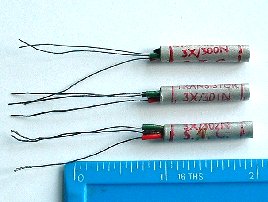
STC's prototype germanium junction transistors 3X/300N to 3X/302N use a 1-inch-long aluminium can, holding a narrow glass tube in which the germanium die is held. The 3X/30n triad is listed in the book 'Transistors and other Crystal Valves' by T. R. Scott, dated 1955, but I suspect that they are several years older than that. If you know anything about them, please
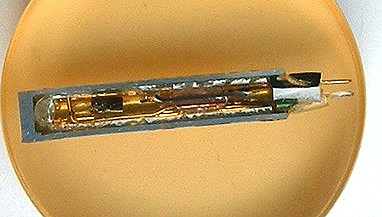
This image shows a 3X/300N transistor that has been cut in half and mounted in acrylic (which has gone rather yellow with age). The germanium die is the tiny black rectangle to which the wires attach. It is also evident that device was prevented from shorting out on the aluminium can by the use of an internal glass tube, sealed at one end.
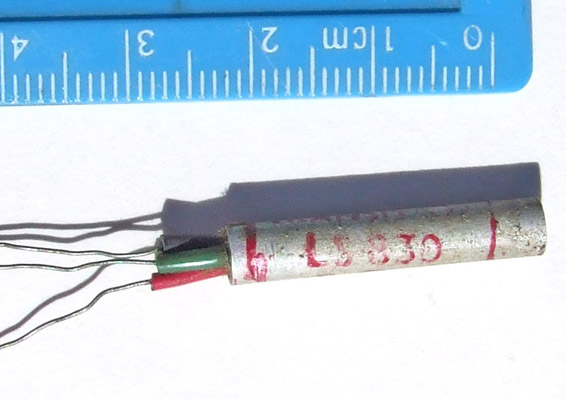
The LS series contains at least two types in this shape: the LS828 and the LS830 (shown). I am seeking LS828, or any other LS type in this can. If you know where I might get any, please
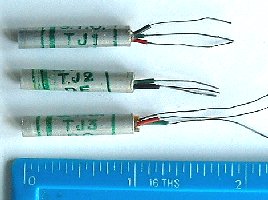
These devices, types TJ1 to TJ3, are STC's first commercial junction transistors, and are presumably production versions of the 3X/30nN types above. They are described in the Brimar Manual number 6 (for 1955). These types can sometimes be found in Brimar boxes such as that shown for the TP2 above. No further types were made in this outline.

The Brimar Manual number 7 (for 1958) lists also TS1 to TS3 germanium junction transistors, which use an improved and smaller metal can, albeit with lower power dissipation of 50 milliWatts compared with 200 mW for the TJ types. The Brimar Manual number 8 (for 1959) expands the range to TS1, TS2, TS3, TS4, TS7, TS8, TS9, TS13, TS14, and TS17. Early examples have green or red printing on bare metal, later ones are painted black with white lettering. Wireless World Radio Valve Data 1958 has TS15 instead of TS17; this is probably an error.
My super-compound image shows most of the types in the series, including examples of TS5 and TS10 for which I cannot find data.
Rarely, these types can be found in Brimar boxes such as that shown for the TP2 above. Unmarked examples from this series, presumably out-of-spec devices, were sometimes sold cheaply to the amateur electronics market as 'white-spot' transistors.
One example exists of this shape of can, but in the early LS series: type LS873. I am seeking this type, or any other LS type in this can. I am also looking for type TS9 needed to complete my lineup! If you know where I might get these, please
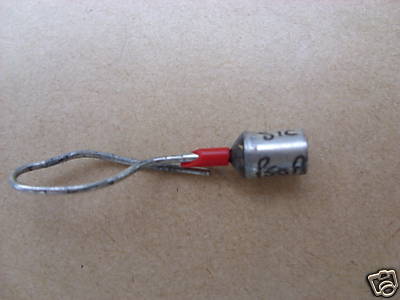
In 1956 STC issued two germanium junction photocells, types PG40A and PG50A. However I have a small STC booklet, also dated 1956, about a type P50A that has identical shape and characteristics to the PG50A. Presumably the name was changed. My image shows one handwritten P50A, which came with a small printed sheet of characteristic data. I am seeking an example of PG40A (or P40A if it too was renamed), and indeed of PG50A if it exists. If you have any, or documentation about them, please
The booklet also describes two rather odd germanium rectifiers, types R50A and R50B. I would be interested to find examples. If you have any, or documentation about them, please
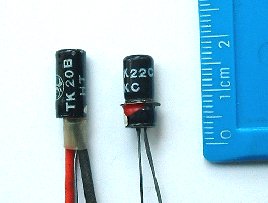
The TK series from about 1959 was STC's first serious production range of transistors, covering all kinds of applications from AF to RF and switching. They usually have a suffix that denotes the encapsulation:
- Suffix A is uncommon and indicates an early outline similar to the TS types above but with a more pronounced 'skirt' at the leads end.
- Suffix B indicates an outline dimensionally equivalent to VASCA SO-2. See the TK20B shown.
- Suffix C is also dimensionally equivalent to VASCA SO-2 but has a cold-weld flange around it. See the TK22C shown.
However some have a double suffix CA which puzzles me. STC denominated the SO2-type outlines as KO-5 or KO-13 (the difference being a tiny tapering of one lead). Often the transistors are painted black, but again this is not always the case, and some are grey metal while some are copper coloured.
The STC Broadsheet 1961 lists the following types, all are germanium PNP alloy-junction:
plus the following germanium NPN junction types:
The STC Summary of Industrial Transistors 1962 has added:
Many of the above also exist with a B suffix rather than C, and some with an A suffix, There are also other TK types:
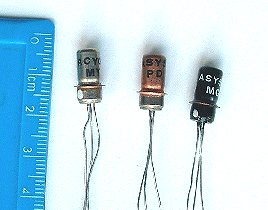
STC changed from using their proprietary TK series, and went on to produce germanium transistors using the standard Pro Electron prefixes ACY, ADY and ASY. The image shows the different appearances possible: black painted, copper-coloured, or grey metallic.
The STC Summary of Industrial Transistors 1963 lists the following types:
I'm seeking examples of ACY29, ASY53, ASY59, ASY61, ASY62, ASY71 and ASY72.
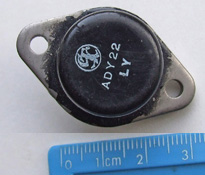

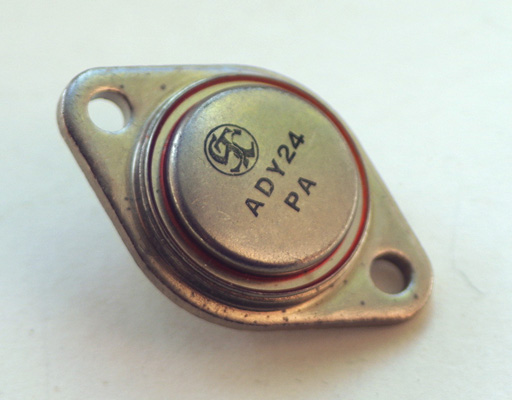
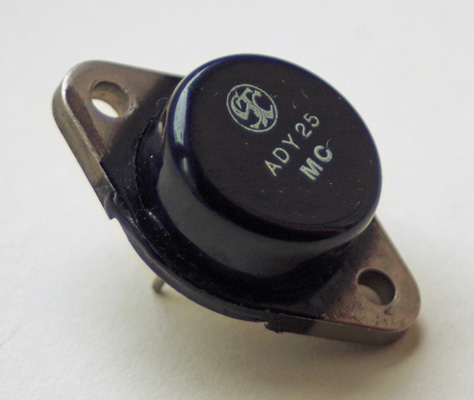
STC appear to have made rather few power transistors, and all use the TO-3 'diamond' package, which STC designated as KO-12, usually painted black with a rather high central 'dome'. There are germanium ones in the ADY series: ADY22 to ADY25. Above are ADY22, ADY24 (in a more standard, unpainted TO-3) and ADY25: I'm looking for an example of ADY23. The two-letter codes on these look like CV date codes, but have invalid values for the CV definition.
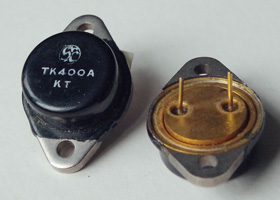
There are a few germanium power types in the proprietary TK series: TK400A to TK403A, also from about 1962. I'm interested in obtaining TK401A to TK403A.
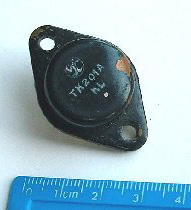
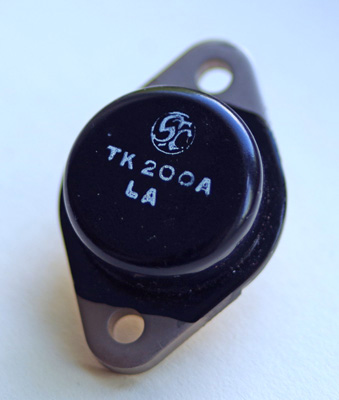
There are also silicon power types in the TK series, namely TK200A to TK202A from about 1961.
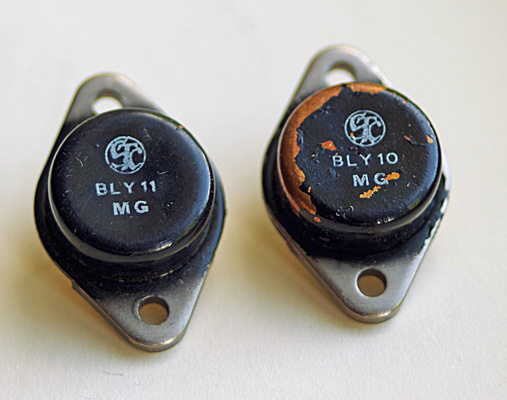
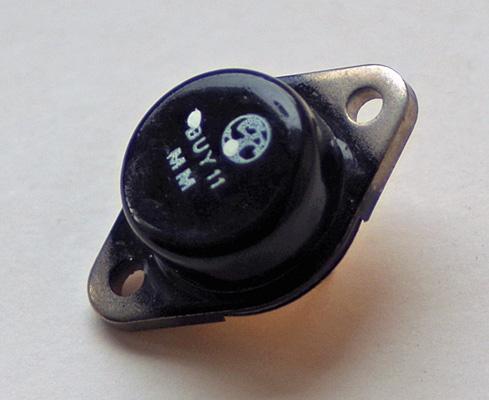
There are more silicon power types in the BUY and BLY series:

During one period STC produced sets of devices just marked MIXER, IF, OP (for 'output'), DR (for 'driver') etc for manufacturers of superhet long/medium wave transistor radios. I don't know the details but it is probable that, like other semiconductor manufacturers, they sold these as one or more sets intended to provide the complete semiconductor line-up for a radio circuit. If you know more about these, please
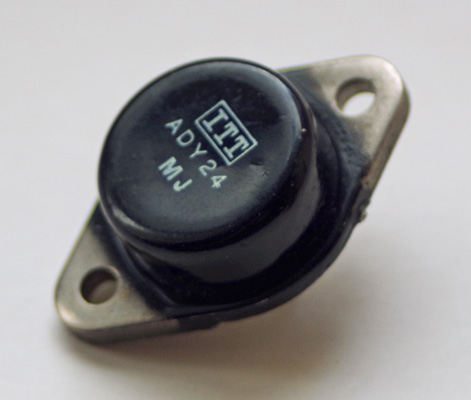
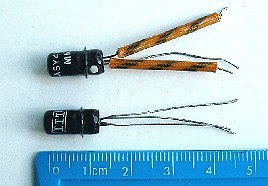
Because STC was in fact owned by ITT, it is possible to find devices from their series branded ITT. The images show an ADY24 and an ASY55. I don't know the significance of this, for example whether these were manufactured for the US market, but it is my suspicion that such examples are later than STC-branded ones.
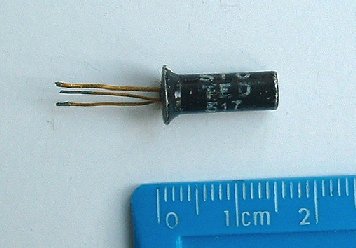
STC had a later series for experimental transistors: the TED series. A correspondent, Graham Norgate, who worked in the Transistor Development Lab at Footscray from 1960-1963 explained to me that TED stood for Transistor Experimental Device. He presumed that all products started with a TED number and then were given a 'proper' number if and when they got into production. My example, TED517, is in the early 'suffix A' style of packaging. If you have any documentation on such TED types, please
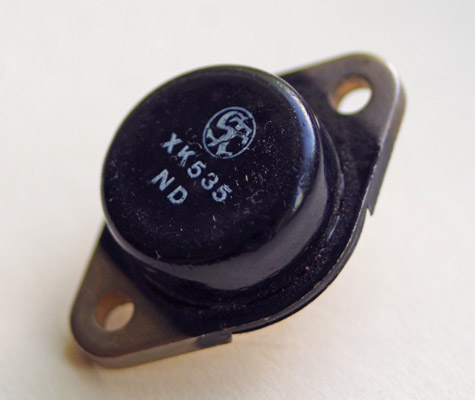
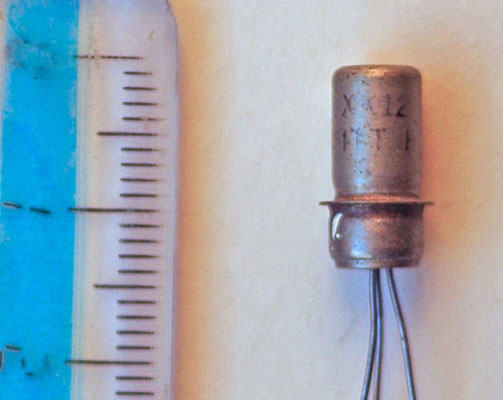
STC made semiconductors in yet another obscure series: the XK series. The 1963 CV Register lists the following, all made by STC:
I have only ever seen two XK series semiconductors, the ITT-branded XK12 shown in the standard STC KO suffix C outline, and this XK535 power transistor. Neither is in the list above. If you have any documentation on such XK types, please
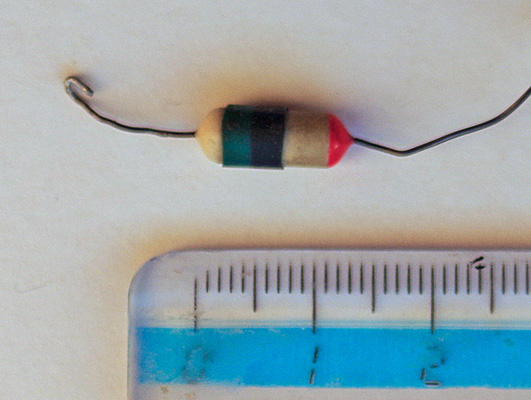
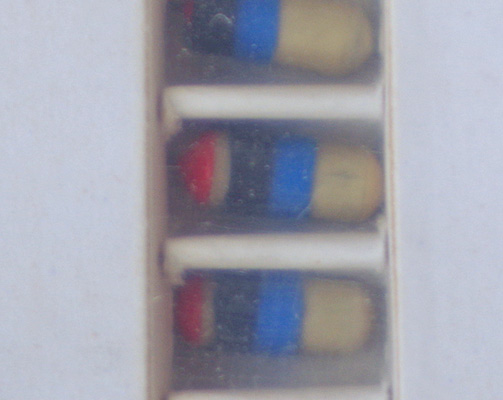
Some early data books like the Wireless World 'Radio Valve Data' book for 1958 list STC germanium diodes with the prefix 2X/, which presumably designates experimental types like the 3X/ transistors. These do not appear in the Brimar manuals.
For a long time I was unsure what these looked like, but this advertisement in Electronic Engineering for February 1954 shows them. They have the same short ceramic body as the GD series (shown below) but have nothing printed on them. Instead they have a bi-coloured rubber or plastic band around them, denoting the type in the electronic colour code. My images show 2X/105G for which the bands are black and green for 05, and four 2X/106G in a box still sealed in polythene, for which the bands are black and blue for 06. Oddly, the box is marked 22/4017G, of which I don't know the significance. I also have some 2X/106G which have black and blue paint dots rather than the stripey band; other varieties may have this type of marking too.

I would be very interested to obtain examples of the other coloured varieties; I believe these should be black-red, black-orange and black-yellow. If you know where I might find any, or original data for them, please
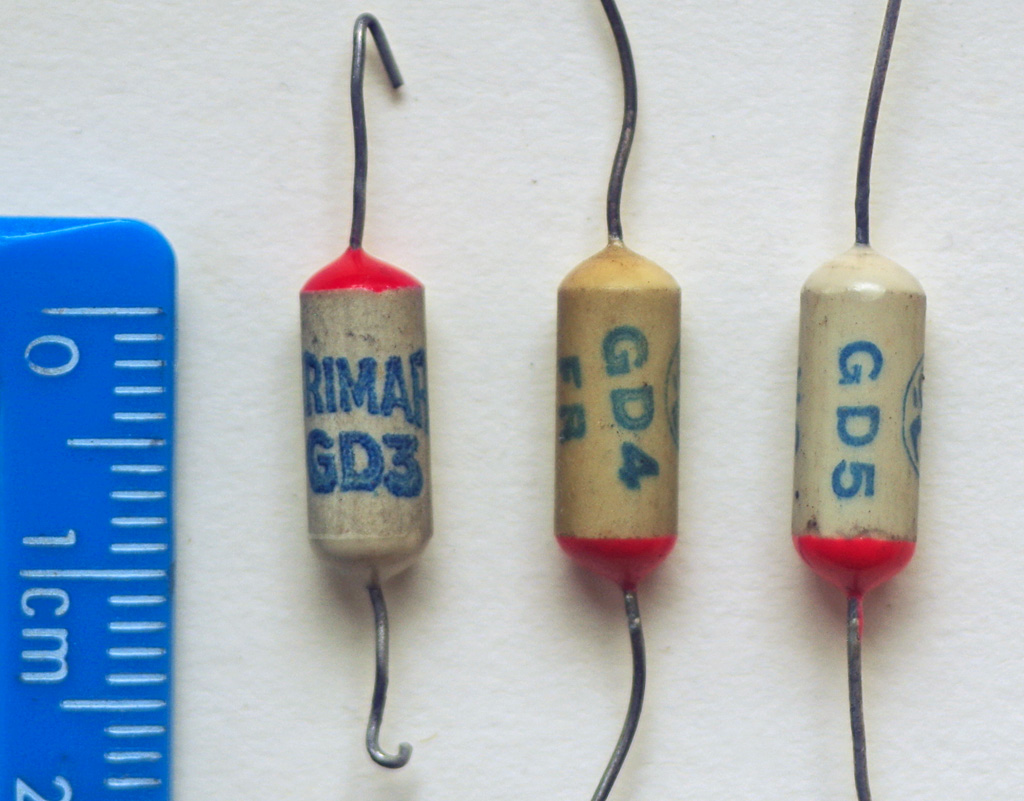
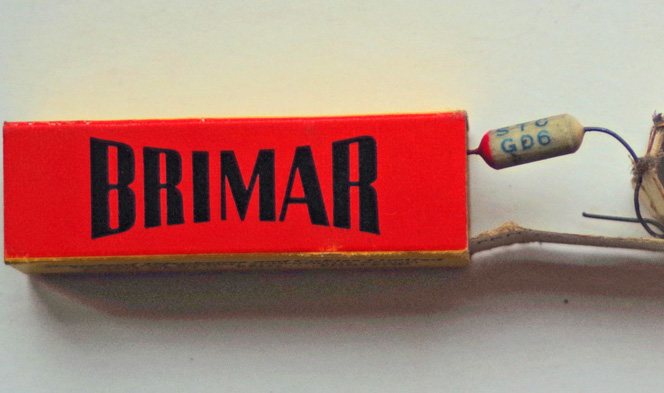
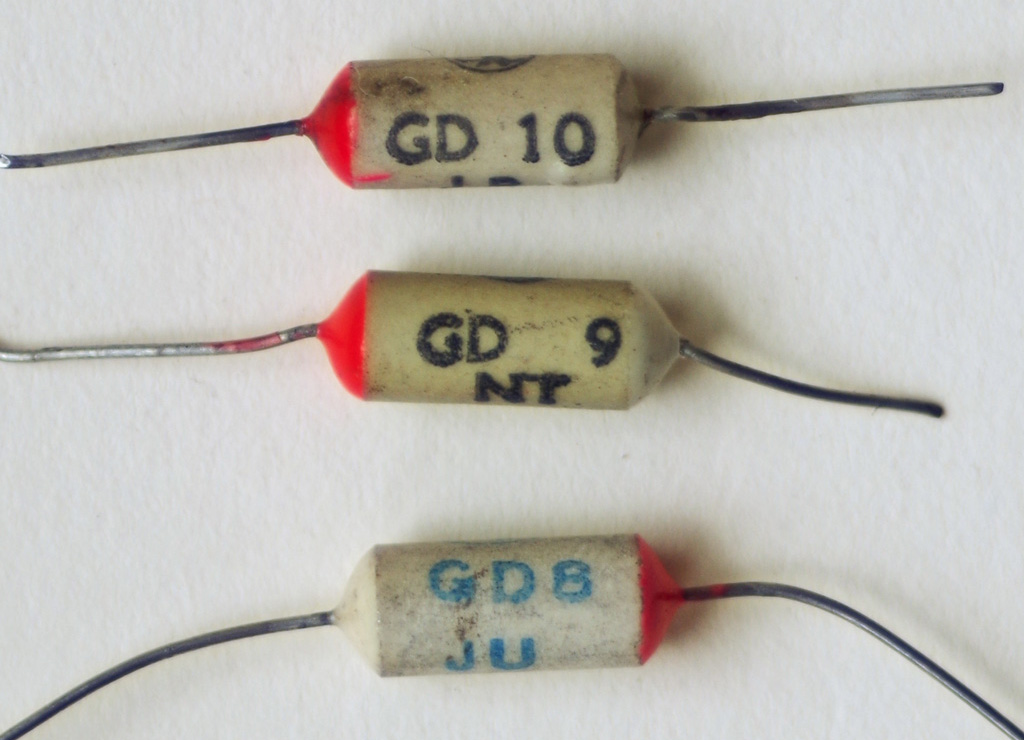
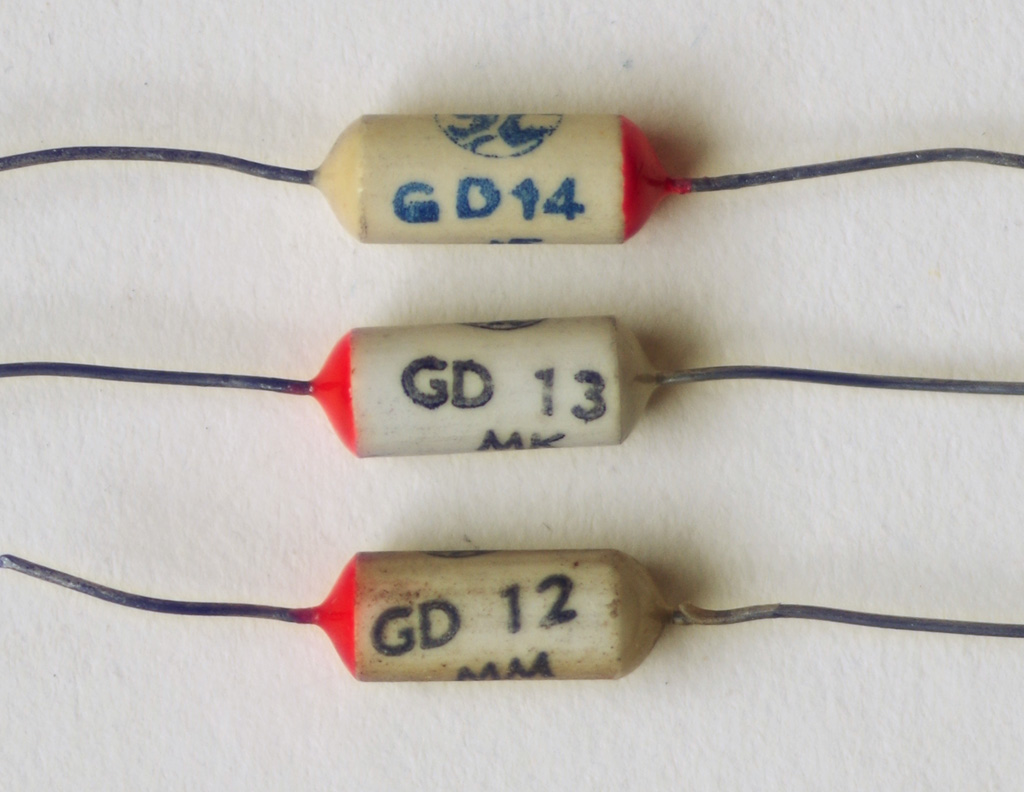
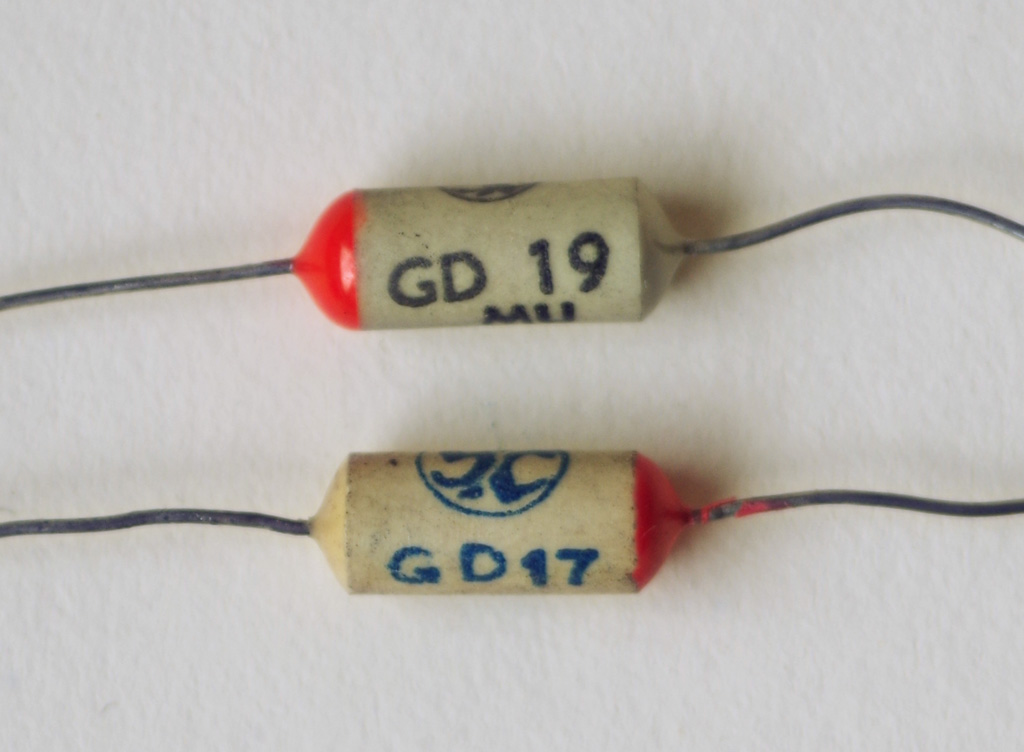
STC manufactured an early range of low-power germanium diodes with the prefix GD, bearing the STC logo (except for the GD3 shown above) but found in a small carton branded Brimar.
I am looking for the ones I need to complete the series: GD11, GD15, GD16 and the hypothetical GD18. If you know how I can fill those gaps, please Of course, I'm also looking for original data for GD17, GD18 and GD19.
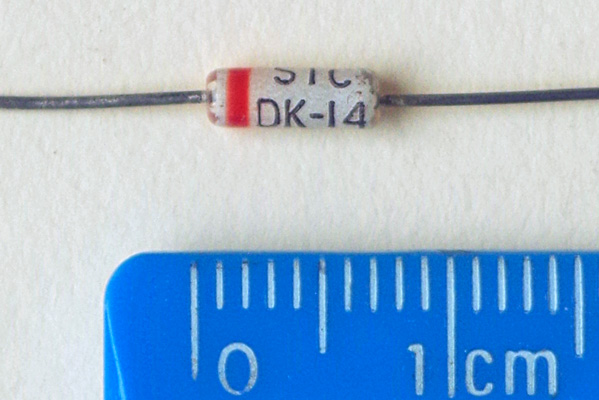
They also manufactured a range of miniature glass-bodied germanium gold-bonded diodes with the prefix DK, although in my experience these are rare. It is an unusual outline for STC, and they bear the letters STC rather than the logo. I have provisional data sheets dated 1961. I have seen examples from this series branded ITT.
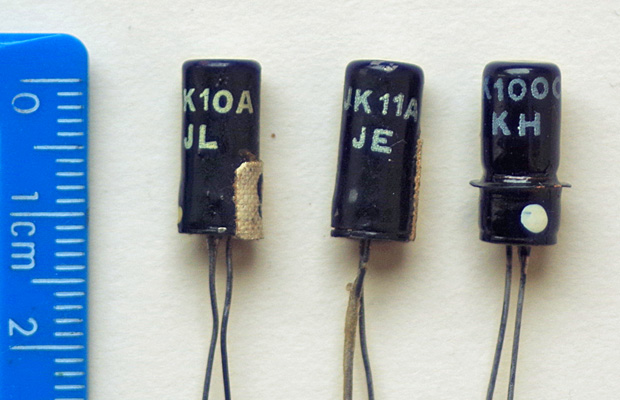
Interestingly, in about 1961 STC offered a range of germanium tunnel diodes with the prefix JK, in their standard KO-5/KO-13 can.
There is also a type JK100A (and JK100C shown, which is not listed in my data books) which STC named a 'backward diode': it is a diode that conducts at a lower voltage than a conventional diode with the same junction capacitance. This makes it suitable as a gating device for use with tunnel diodes.
For these, the suffix A does not denote the smaller outline that it implies for STC's transistors. I don't understand why these are not suffix B.
Later, STC made a number of series of silicon diodes, all printed STC rather than bearing the logo:
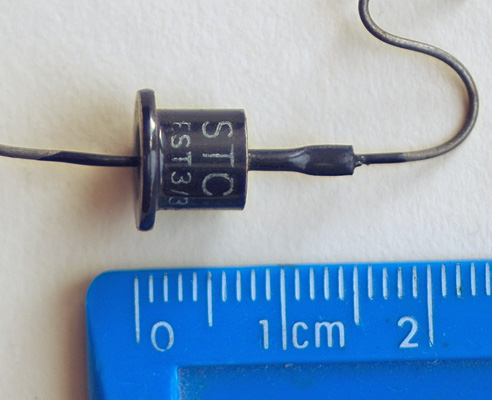
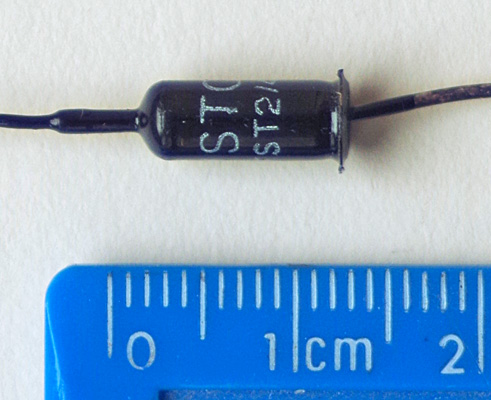
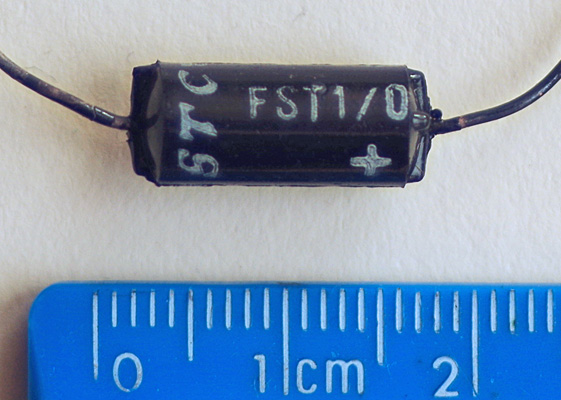
The FST1 (leftmost image is FST1/0) uses a largish plastic cylindrical body. FST2 (middle image FST2/4) has a smaller metal cylindrical body, and FST3 (rightmost image FST3/3) uses the standard VASCA SO-16 or JEDEC DO-1 metal case. The only ones of these for which I have data are FST1/4 for which I have a 1959 data sheet, and FST3 which is listed in the STC 'Semiconductor Data Summary' for 1966 with qualifiers /1 to /6 denoting max reverse voltages from 100 Volts to 600 Volts. I have seen on eBay examples of FST3 branded ITT and in a standard DO-1 outline. I would be interested in original data for others so if you have any documentation for them, please
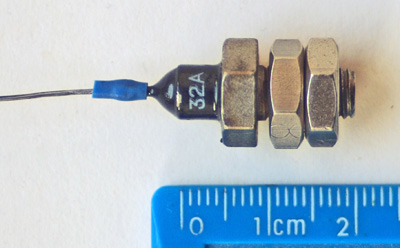
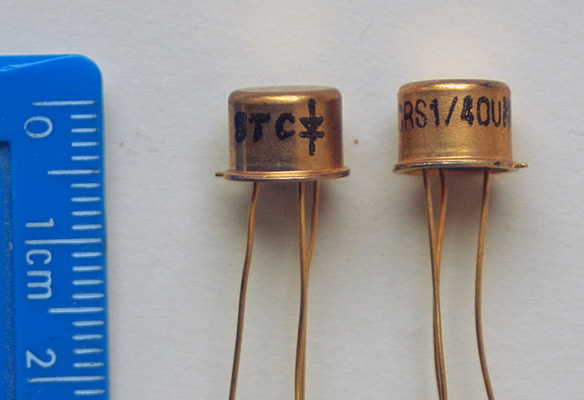
The STC 1966 'Semiconductor Data Summary' contains an extensive set of Silicon Controlled Rectifiers (SCRs or 'thyristors'). The part numbering is based on the device maximum current and voltage: a typical example is CRS25/20AF which is a 25 Amp device with max. reverse working voltage of 200 Volts. Most are in a typical threaded stud package, but the lowest current set uses the TO-5 outline, such as this CRS1/40.
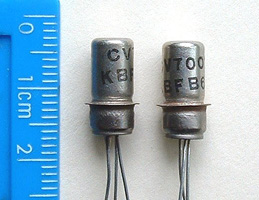
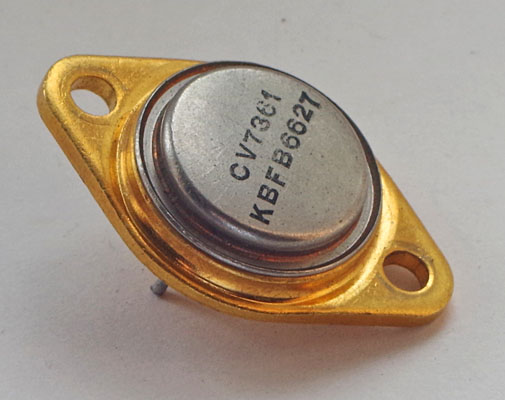
Being a major supplier to the UK government, many STC types are included in the military CV series, especially diodes. My images show a CV7001 which the Register states is equivalent to a TK23 transistor and a CV7361 which is equivalent to TK203E (I don't know what the suffix E signifies, STC usually used suffixes to specify the outline) or BUY11. I would be interested to see the following STC CV types (beware that some may also be made by other manufacturers, true STC examples should have the manufacturer code FB for STC Footscray):
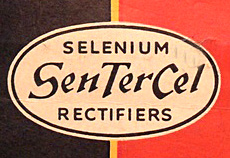
The Brimar manuals contain a number of pages on selenium 'metal rectifiers', which STC marketed under the name 'SenTerCel': note the capital letters. These are are also listed (under 'Brimar') in the book 'Wireless World Radio Valve Data 1958'. According to an older booklet that I have seen, 'selenium metal rectifiers were first introduced into England in 1930 by STC, who commenced manufacture a few years later'. The classic shape for such a 'metal rectifier' is a large cuboid or cylinder of cooling fins, with the actual rectifying discs along the central axis, and two or more tag connectors sticking up from the fins. This type is often a high-voltage rectifier for use in valve/tube circuitry, although some later examples have lower voltage and higher current ratings.

From about 1946 STC made miniature low-voltage types in several outlines, intended for use as half-wave or bridge rectifiers in instrumentation.These miniature types were called 'Uniplate rectifiers', even though the bridge types obviously contain four 'plates'. My image shows their shape. Few of them seem to have survived. They are a bit of a diversion but I would be interested to obtain some for my collection so if you have any, or documentation for them, please
The Brimar Valve Manual number 7 (for 1958) lists the following metal rectifiers:

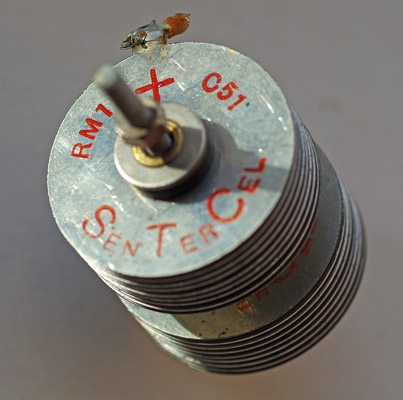
- 'Half-wave' rectifiers RM0, RM1, RM1A, RM2, RM3, DRM1B, DRM2B, DRM3B, RM4, RM4B, RM5, SB2, SB3.
These are the classic finned type and some can usually be found on eBay. The image shows two type RM1 that have been connected in series, this could be a DRM1B, the documentation is not very detailed.
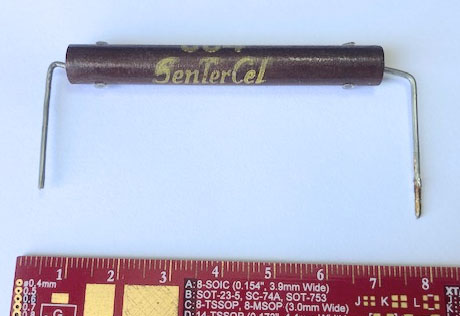
- 'Replacement rectifiers' K3/15, K3/25, K3/40, K3/50, K3/100.
These are high-voltage rectifiers with many discs in a long cylinder. Thanks to Mark for this image of a K3/25.
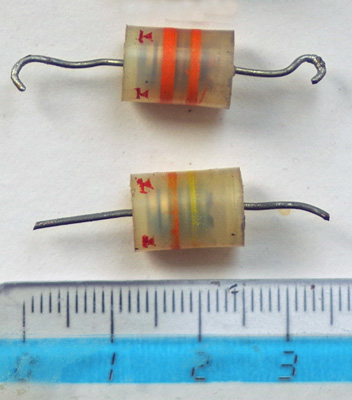
These comprise one or more discs inside a small plastic cylindrical case with the type colour-coded in stripes around the body and axial lead wires. They are easily mistaken for resistors or capacitors. The image shows Q3/4 on the bottom and Q3/3 on the top. I have now come across one of these in a slightly longer ceramic body, with an additional silver stripe that looks like a tolerance value. I suspect that this is an earlier version, which STC called 'Unistors' and described as 'asymmetrical resistors' (!) as shown in this advertisement from 1953. It gives 'specimen data' for types Q1/1, Q3/1, Q6/1 and Q8/1 which use the same naming convention as the 'replacement rectifiers' but not exactly the same numbers.
If you know anything about these devices, please
- 'Replacement rectifiers' D3/2/1Y, V3/2/1Y and V3/1/1Y.
The manual has an image of a small cuboid with three leads out of one face.
- 'Contact-cooled rectifiers' C2H, C3H, C2D, C3D, C2V, C3V and C3B.
These are selenium diodes potted into cuboids with a plate on one face for bolting onto a heatsink, and connecting tags on the rear. They are multi-function, some can be used as half-wave rectifiers (suffix H), some as voltage doublers (suffix D), some as 'push-pull' and C3B as a full-wave bridge rectifier.

The STC 'Broadsheet' for 1962 lists a number of 'integrated circuits' containing germanium tunnel diodes. They are:
I have never seen these and do not even know what they look like. All tunnel diode products have disappeared in later STC publications that I possess. If you know anything about these CK devices, please